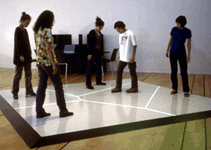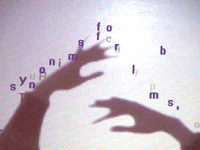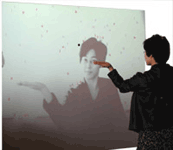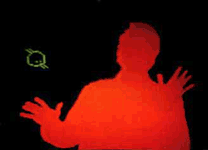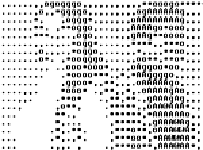 |
||
| softcore news < studios < articles < hardcore firms < jobs < schools < links < calendar < sources < discussion < how to < Check out Bruce Sterling's and Engram's Offsite! |
||


> > archived articles > write for core! be famous!
|
Designing Systems for Human Interaction, Not Human-Computer Interaction by Camille Utterback I am a 32 year old artist, in a booming metropolis, at the dawn of the 21st century. I am armed with a couple of computers, a pile of camera equipment, some programming skills, a good exhibit track record, my own company, and an amazing network of friends and colleagues. I want to change how people think about their relationship to technology. I want to bring our physicality, our bodies (a large part of what makes us human) back into the equation. I am passionate about creating experiences that show people that their interactions with computers do not have to be frustrating, deadening, and potentially debilitating. Instead, we can imagine and create a world where this interaction is seamless, intuitive, playful and inspiring. By using video cameras to create physical-digital systems that engage people's bodies instead of just their fingers and eyes, I hope to refocus attention on the embodied self in an increasingly mediated culture. Additionally, my video-based interfaces, by allowing many users simultaneously, create social spaces focusing on human interaction, not human-computer interaction.
When historians look back at these early physical-digital experiments that my many colleagues and I are creating now, perhaps these pieces will look like early daguerreotypes--lacking polish and definition--but I think we've begun down a path that will be remembered as the beginning of an evolution in design. In Donald Norman's book, The Invisible Computer, he points out that we no longer buy "motors" (as was once the case). We buy "blenders" or "hair dryers". When motors became cheap enough, they disappeared into consumer objects designed for specific purposes, and were no longer purchased as separate objects. Artists and designers like myself are beginning to put an end to the "computer". Physical-digital objects will evolve and proliferate, taking many forms from consumer objects, to custom designed exhibit design, to art work. Physical-digital interfaces will not be novel, they will just be used. The appeal of my work lies not in the fact that it uses technology in a new way, so much as it allows the technology to disappear, and lets people enjoy a physically-based, human-centered experience. So what do I make? As mentioned, most of my interactive installations to date use a video camera as an input device. Video data provides much richer information about the world than a mouse and keyboard input device do. I write custom software to process the incoming camera signal to glean information about users' positions, motions, or gestures in the installation space. Imagery is then generated and projected in response to the camera input. The effect is that the images on the screen appear to magically and transparently respond to people in the space. A secondary, but no less important effect, is that using a video camera as an input allows for many people to interact with my systems at once. This helps my installations to become social spaces where people interact with each other as much as with the system I've developed. I have developed a number of installations (www.camilleutterback.com, www.creativenerve.com) that respond to users in different ways, but for this article I will concentrate on discussing Text Rain, created with Romy Achituv in 1999. 'Text Rain' is the oldest, and perhaps most well known of my video tracking based works. In the Text Rain installation, visitors see a live black and white video projection of themselves. Colored letters drift down the screen like rain or snow and can be caught and lifted by people's heads, limbs, or any other object in the video image. As one set of colored letters fall, they fade and are replaced by new letters from above. The lines that fall are form a poem about bodies and language. If participants catch enough letters they can read words and phrases from the poem.
|
||||||
|
|
||||||
| >>
back to top >> back to core |

